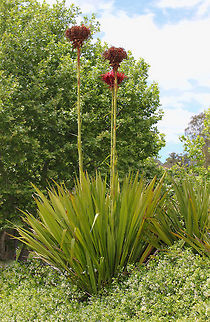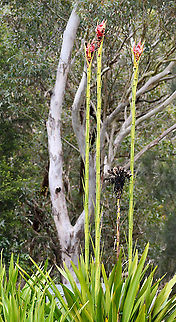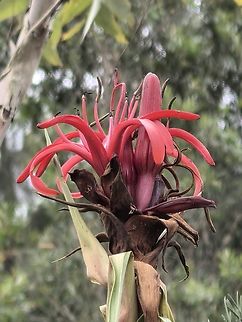
Appearance
Gymea lilies have a rosette of large numbers of sword-shaped, strap like leaves 1–2.5 metres long and 10 centimetres wide. The leaves are bright green, fibrous and glabrous.In winter the flower spike grows from the centre of the rosette until it is up to 6 metres high, bearing shorter leaves up to 30 centimetres long. At the top of the spike, a head of flowers 30 centimetres in diameter develops, each flower being bright red, trumpet-shaped and about 10 centimetres long.
The head is surrounded by reddish-brown bracts, sometimes making it difficult to see the flowers from the ground. Flowering occurs in spring and is followed by oval-shaped reddish-brown capsules, 7–10 centimetres long. In late summer, the capsule splits open and releases the seeds which are 15–23 millimetres long.

Naming
"Doryanthes excelsa" was first formally described in 1802 by the Portuguese polymath, José Correia da Serra from the type specimen collected by George Bass "in mountainous parts of the colony of N.S.W.".
Distribution
"Doryanthes excelsa" occurs in woodland and dry sclerophyll forest in coastal areas and adjacent mountains from Karuah to Mount Keira. It usually grows in soils derived from sandstone.
Habitat
"Doryanthes excelsa" occurs in woodland and dry sclerophyll forest in coastal areas and adjacent mountains from Karuah to Mount Keira. It usually grows in soils derived from sandstone.Cultural
Gymea lilies are hardy and adaptable plants often used in landscape gardening, not only in the Sydney region but also in other coastal areas such as Brisbane and Perth. Plants can be grown from seed but may not flower for up to eight years. Flowering can be encouraged by fire and by carefully placing a stone in the centre of the rosette.References:
Some text fragments are auto parsed from Wikipedia.